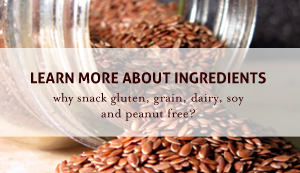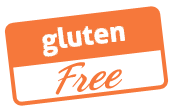
Have you ever wondered what the benefits are of not eating gluten, grain, dairy, soy, and peanuts? We will try to break down the dietary and lifestyle benefits so you can see the difference of being Snackin’ Free!

Gluten is the protein “glue” that gives wheat, barley, and rye flours their stretchy texture when kneaded into dough. It is commonly found in baked goods, bread, cakes, cookies, cereal, pasta, beer and a host of other processed foods like canned soups, sauces and even jelly. Although gluten intolerance is associated primarily with Celiac disease and IBS (Irritable Bowel Syndrome) there are approximately 75-80% of ALL people who may benefit from avoiding gluten and grains, including whole sprouted grains, whether you have a gluten intolerance or not. This is because, grains rapidly break down to sugar, which causes rises in insulin that exacerbate health problems such as: being overweight, high cholesterol, high blood pressure, Type 2 diabetes and Cancer.
People who live a gluten free lifestyle have a higher risk of fiber deficiency. However, at Snackin’ Free use only high fiber flour substitutes such as nut flours and coconut flour that meet or exceed the nutritional and fiber requirements while still remaining completely gluten free. A diet high in fiber leads to health benefits like improved bowel health, healthier blood lipid profiles, blood sugar control and obesity control. Coconut flour is a gluten free, high-fiber, high protein, low carbohydrate and low glycemic food; it is an excellent source of vitamin E which has been shown to aid in lowering cholesterol and reduce the risk of many diseases including Alzheimer’s, diabetes and heart disease.
Of all the varieties of nuts, almonds are the highest in calcium which aids in everything from building and maintaining healthy teeth and bones to regulating blood pressure. Almonds are also an excellent source of magnesium which aids in the building and maintenance of bones and teeth, assists in the absorption of calcium and in help maintain proper muscle tone. Almonds are high in copper which is an essential mineral that acts as an antioxidant, maintains healthy function and integrity of bones and tissues, protects nerves and helps the body process iron efficiently. Eating nuts regularly can help your cholesterol and metabolism.
![]()
 The most common reasons for making the choice to be Grain free is due to illnesses like Celiac Disease, IBS (Irritable Bowel Syndrome) and wheat or other grain allergies. Some find that going totally grain free aids in avoiding GMO (genetically modified organisms) since almost all grains grown in the US have been genetically modified to increase production and disease resistance. Making the decision to go grain free can help with weight loss. Diabetics often find that going grain free helps regulate blood sugar. Research has shown a grain free diet can have a positive effect for those suffering from brain fog, obesity, diabetes, Alzheimer’s disease, autoimmune disease, autism, heart disease, cancer and host other debilitating health issues.
The most common reasons for making the choice to be Grain free is due to illnesses like Celiac Disease, IBS (Irritable Bowel Syndrome) and wheat or other grain allergies. Some find that going totally grain free aids in avoiding GMO (genetically modified organisms) since almost all grains grown in the US have been genetically modified to increase production and disease resistance. Making the decision to go grain free can help with weight loss. Diabetics often find that going grain free helps regulate blood sugar. Research has shown a grain free diet can have a positive effect for those suffering from brain fog, obesity, diabetes, Alzheimer’s disease, autoimmune disease, autism, heart disease, cancer and host other debilitating health issues.
![]()

Whether backed by research or thousands of personal success stories, many people are squashing daily headaches, migraines, rashes, stuffy sinuses, chronic infections, arthritis pain, and even narcolepsy when they cut out all dairy foods. Still others are finding a notable reduction in behavioral issues with conditions such as ADHD and Autism when they eliminate dairy, and sometimes gluten (though believe it or not, a large report found that dairy-free has a bigger impact!). About 30 million people in the United States have some degree of lactose intolerance by age 20, according to the National Institutes of Health. Lactose is the sugar in dairy products which you’ll find in more than milk—it’s in baked goods, salad dressings, non-dairy creamers, gravies, sauces, margarines and shortenings and a variety of processed foods. Eliminating the lactose from your diet may help improve the absorption of nutrients from other foods, and weight loss is a real possibility with the dairy-free transition, Numerous research studies have shown strong ties identified between milk consumption and both ovarian and prostate cancers. Believe it or not, according to the landmark Harvard study of approximately 78,000 female nurses, women who consumed greater amounts of calcium from dairy foods had a significantly increased risk of hip fractures, while no increase in fracture risk was observed for the same levels of calcium intake from non-dairy sources. According to NIH casein-free diets are favored by many parents of children who have autism. Casein is actually the protein in milk. Searching for ingredients that include “lact” make it simpler to exclude milk products.
![]()

Far from being the health cure it is purported to be, “thousands of studies link soy to malnutrition, digestive distress, immune system breakdown, thyroid dysfunction, cognitive decline, reproductive disorders and infertility – even cancer and heart disease,” says Dr. Kaayla Daniel, author of the book The whole Soy Story:The Dark Side of Americas Favorite Health Food.
Soy contains toxins called anti-nutrients which inhibit the enzymes needed for protein digestion such as hemagglutinin, goitrogens and phytates. Hemagglutinin – a clot promoting substance, Goitrogens – disrupt the production of thyroid hormotes, and Phytates – which inhibit the absorption of minerals calcium, magnesium, Iron and zinc. Soy contains high levels of Aluminum due to chemical process including acid washing in Aluminum tanks and Manganese which is 80 times higher than in human breast milk. Soy is sprayed with pesticides and 80% of soy grown in the US is genetically modified – visit www.mercola.com to learn how to get the benefits of Soy without the health risks. Soy is on the World Health Organization list of the eight most significant food allergens – those most commonly affected are infants and young children with serious allergies to peanuts. There are at least 16 potential soy protein allergens that have been identified, but the clinical relevance is unknown. Soy milk is often used as an alternative to cow’s milk in lactose intolerant or allergic infants, however some potential exists for allergic cross reactivity. Soy can be healthy in a fermented state only after a long fermentation process, the phytate and anti-nutrients levels are reduced and their beneficial properties become available to your digestive system.
![]()

It is estimated that approximately 0.6-1.0% of the population suffers from peanut allergies. Peanuts are not tree nuts like almonds, cashews, walnuts, etc. which grow on trees. Peanuts grow underground and are part of a different plant family, the legumes. Other examples of legumes include beans, peas, lentils and soybeans. Trace amounts of peanut can cause an allergic reaction. The exact cause of someone developing a peanut allergy is unknown. The Asthma and Allergy Foundation of America estimates that peanut allergy is one of the most common causes of food-related death.
